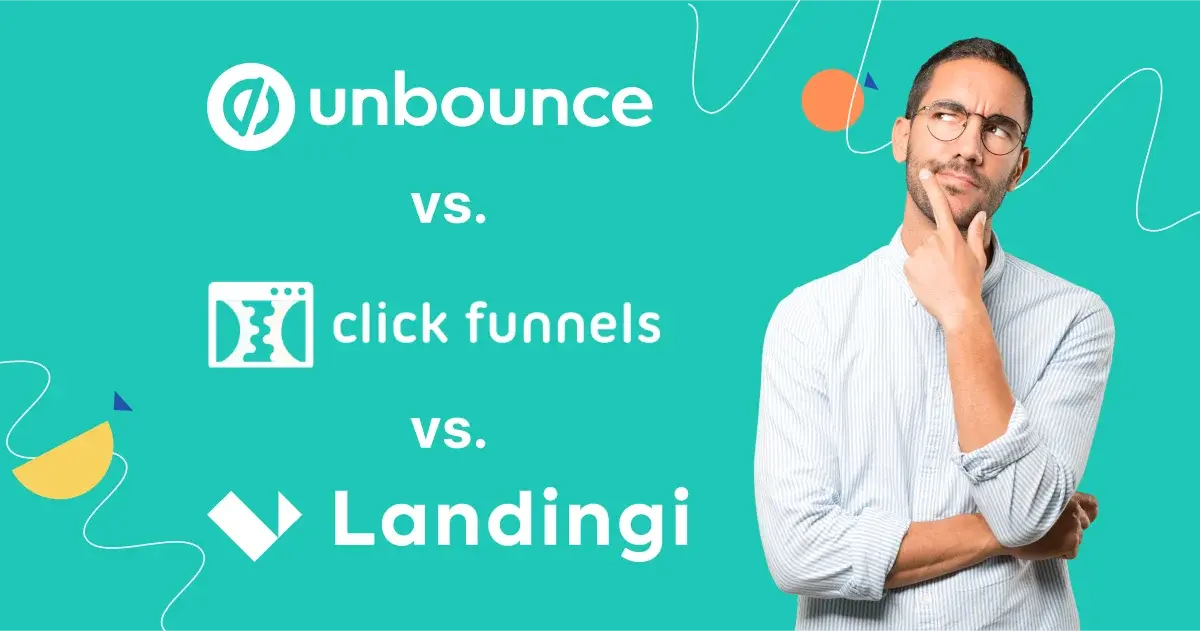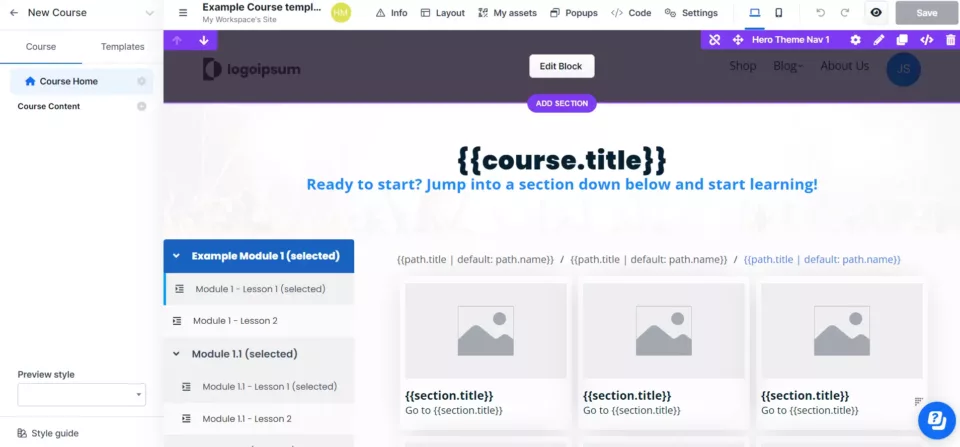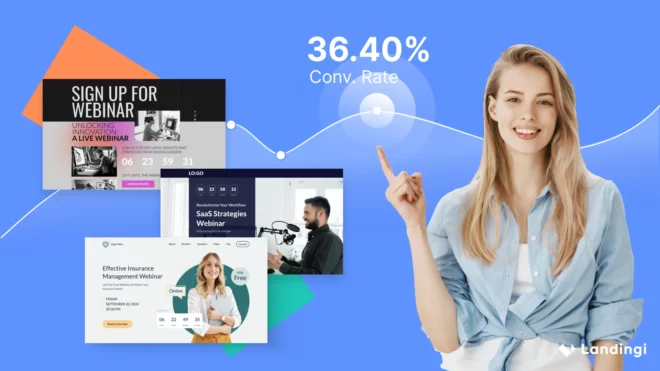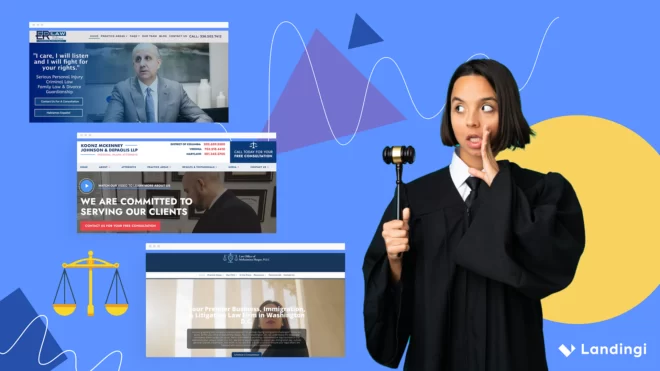Unbounce, ClickFunnels, and Landingi are three popular choices for landing page builders today. However, each comes with its pros and cons.
Unbounce and ClickFunnels are rather expensive, with prices starting from $74/month and $127/month (annually), respectively. However, they promise a broad set of advanced features. So are they worth the price tag?
Meanwhile, Landingi is the most affordable option. There’s a free version available and paid plans start at $50/month (annually). But how does it stack up against the other two platforms?
This guide will dive into the nitty-gritty of each tool. We’ll explore their features, examine their page builders, and more, so you can make the right choice.
Make your sections smartable and let go of mundane manual tasks with Smart Sections! An easy way to manage bulk changes.
Unbounce Vs. ClickFunnels Vs. Landingi: Key Differences
| Unbounce | ClickFunnels | Landingi | |
| Pricing range (yearly) | $74 to $469/month | $127 to $208/month | Free to $139/month |
| Number of templates | 100+ | 160+
(Marketplace templates excluded) |
400+ |
| Integrations | 52 | 10 | 150+ |
| Page builders | Drag-and-drop and AI-powered editor | Drag-and-drop editor | Drag-and-drop editor |
| Smart sections | Yes | Yes | Yes |
| Widget placement | Snap-into-place and pixel-perfect | Snap-into-place | Pixel-perfect |
How Do The Page Builders Compare?
Unbounce
Unbounce offers an AI-powered editor and a standard one.
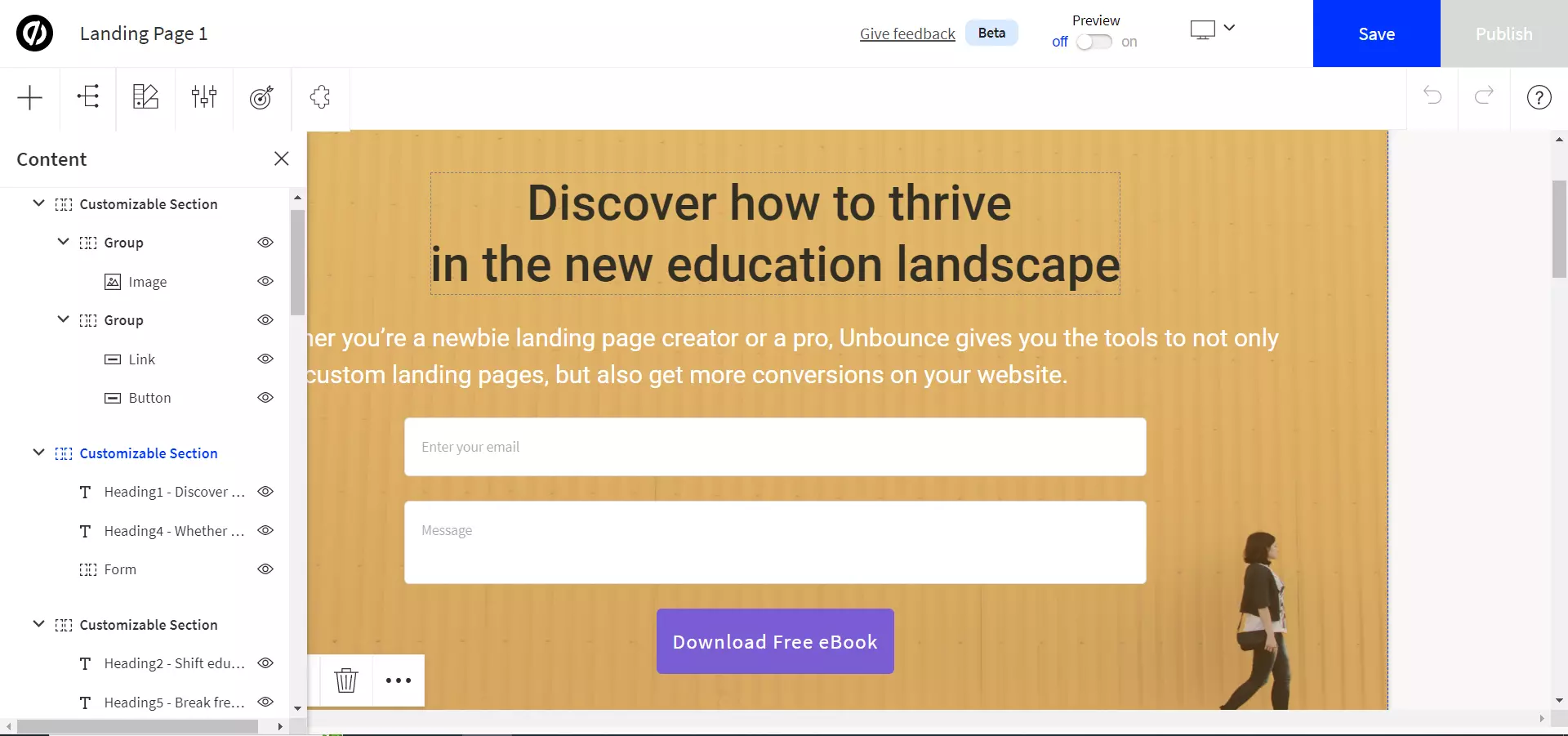
Unbounce’s AI-powered editor, the Smart Builder, uses Artificial Intelligence to generate landing pages automatically. To create a page, select your company’s industry, the landing page’s purpose (e.g., generate newsletter signups, promote discounts, etc.), and whether you want to include a form.
Unbounce will then generate a landing page layout based on your choices. From there, you can add extra widgets (e.g., buttons, images, and text boxes), change colors, and more. As for widget placement, Unbounce includes a drag-and-drop interface. Elements snap into place through pre-determined grids.
Additionally, the platform allows you to preview and modify the page’s layout across multiple viewports (desktops, tablets, and mobile devices), but not independently — each change made on a specific viewport will automatically apply to the others.
Note: The Smart Builder is still in its Beta phase, so expect future changes.
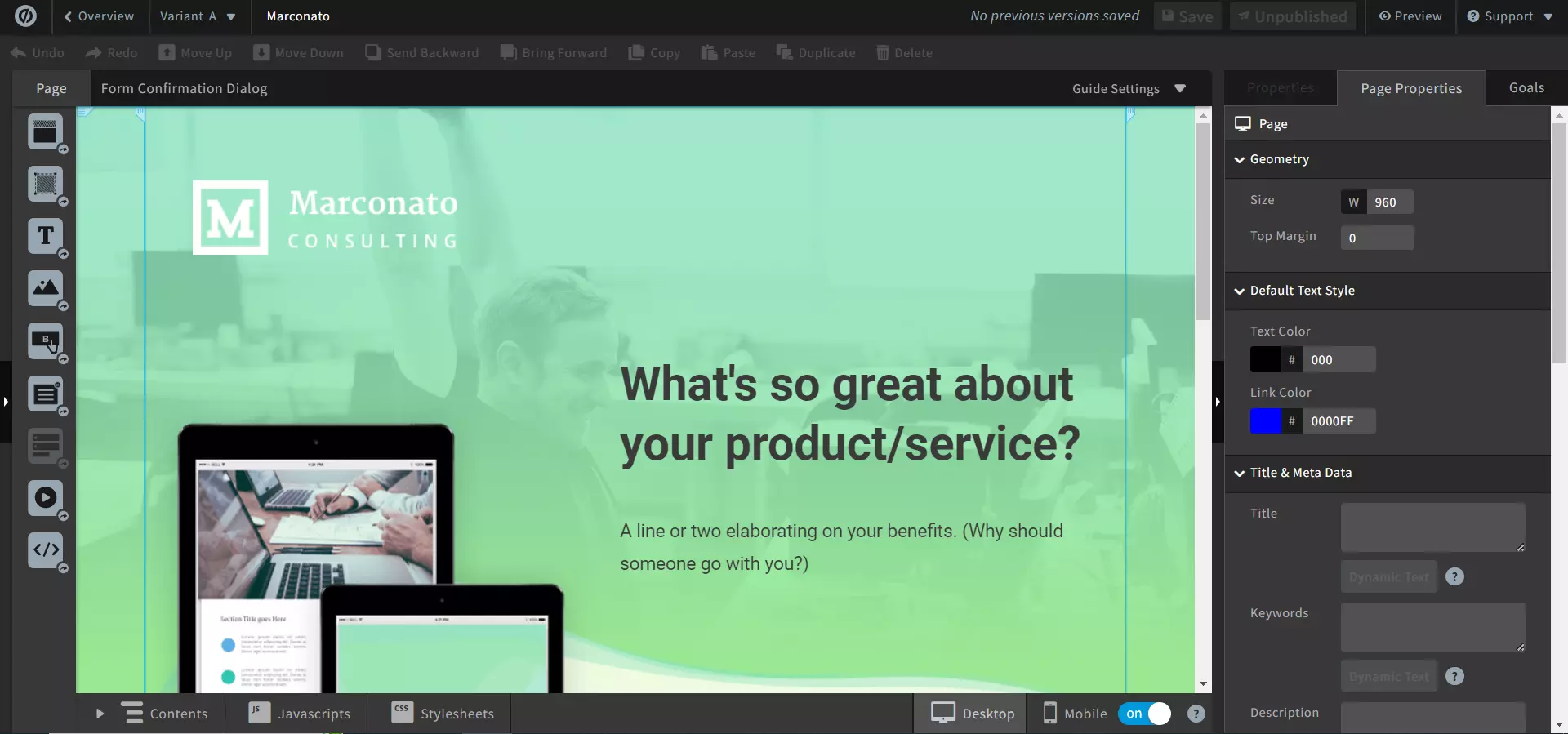
Unlike the AI editor, the Classic Builder offers a pixel-perfect interface, meaning that you can place design elements wherever you like.
Moreover, this editor allows for more control over viewport customization. You can enable/disable page elements on desktops and mobile devices independently (the Classic Builder lacks tablet previews).
The standard editor also allows custom HTML, JavaScript, and CSS coding.
ClickFunnels

ClickFunnels allows you to customize pages via a drag-and-drop interface. You can add widgets, section templates, and popups via the menu in the upper part of the screen. However, elements snap into place, making customization slightly restricted.
As for viewport customization, there’s the Desktop/Mobile Only functionality, where you can independently modify your page’s layout for either desktops or mobile devices.
ClickFunnels also includes custom HTML, JavaScript, and CSS coding.
Landingi
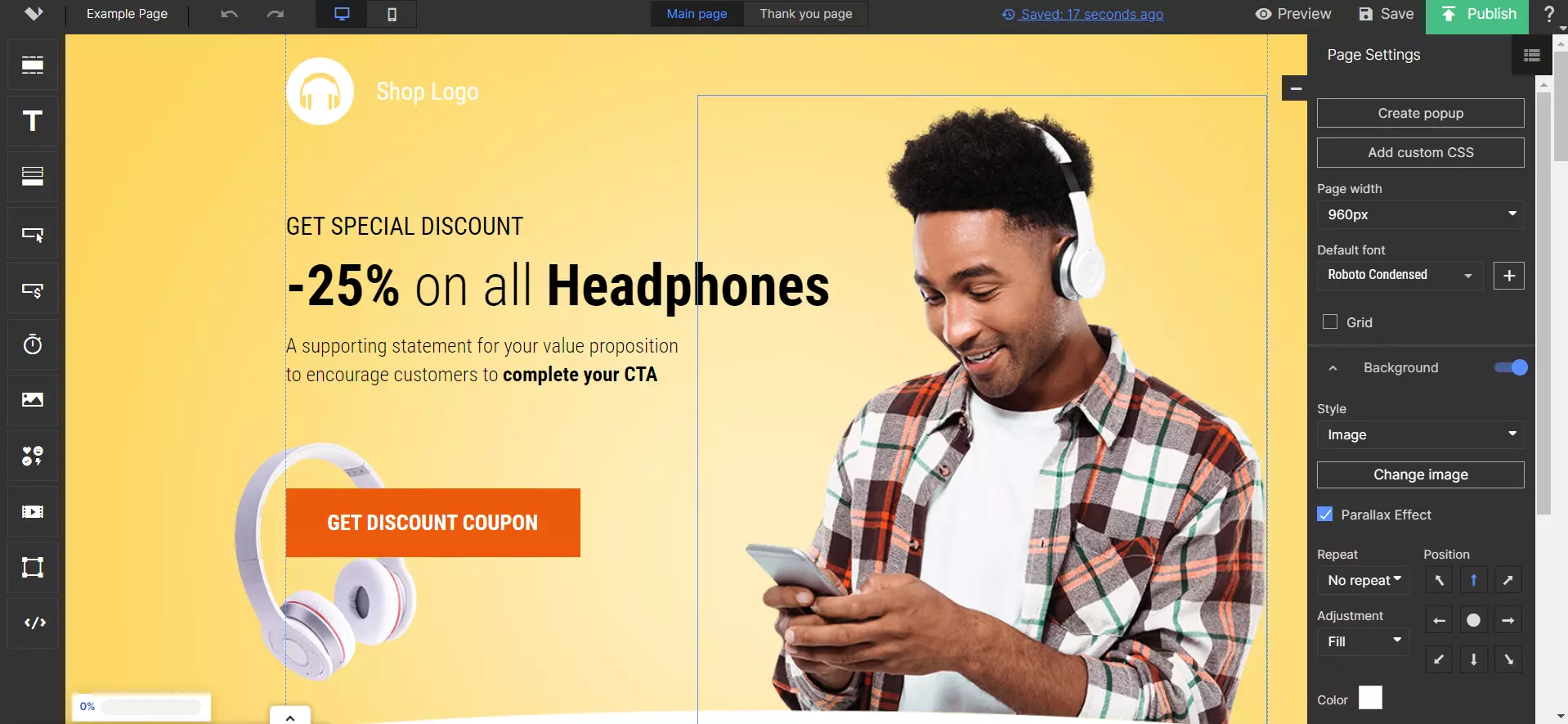
Landingi offers a pixel-perfect drag-and-drop interface. The builder’s UI is straightforward — the right-hand menu includes the platform’s widgets (e.g., countdown timers, images, icons, videos, etc.), while the left-hand menu allows you to tweak pages, sections, or individual elements in more detail.
For instance, you can change a button’s label, color, text alignment, font, and more. Meanwhile, you can add meta titles/descriptions, parallax effects, custom CSS, and create popups through the page settings.
Additionally, you can switch between mobile and desktop views in the top portion of the screen and tweak each viewport separately. You can hide design elements, change their placement, and more.
Comparing Available Templates
Unbounce
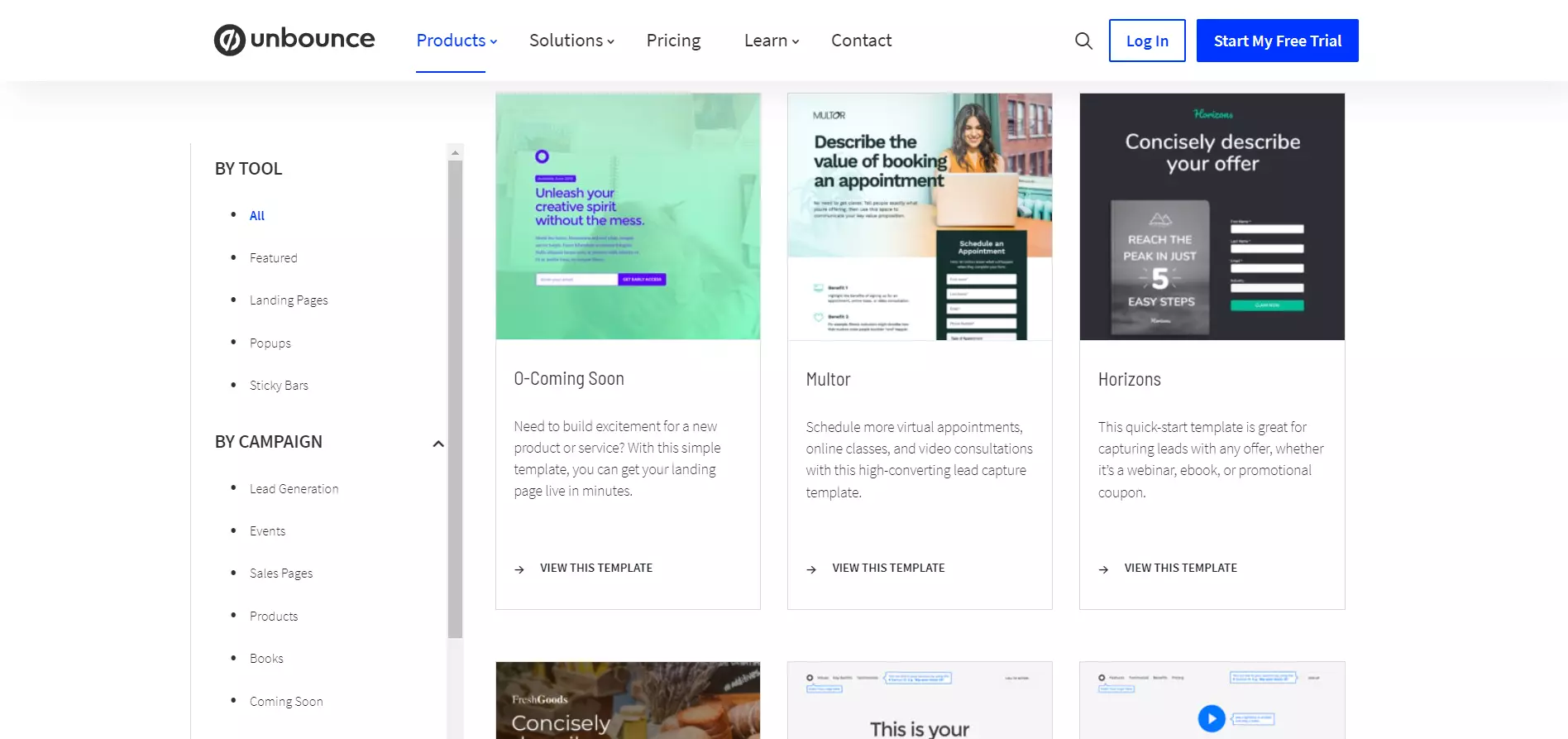
Unbounce offers 100+ fully-customizable templates across the following categories:
- By tool (e.g., sticky bars, popups, and landing pages)
- By campaign (e.g., coming soon, click-through, webinar, etc.)
- By type (e.g., restaurant, consulting, real estate, eCommerce, etc.)
- Special features (e.g., parallax effects, video backgrounds, and lightboxes)
The landing page category includes around 90 templates. As for popup and sticky bar templates, there are 34 and 21 available, respectively.
Lead generation templates seem to be the most popular, with 70 currently available.
ClickFunnels
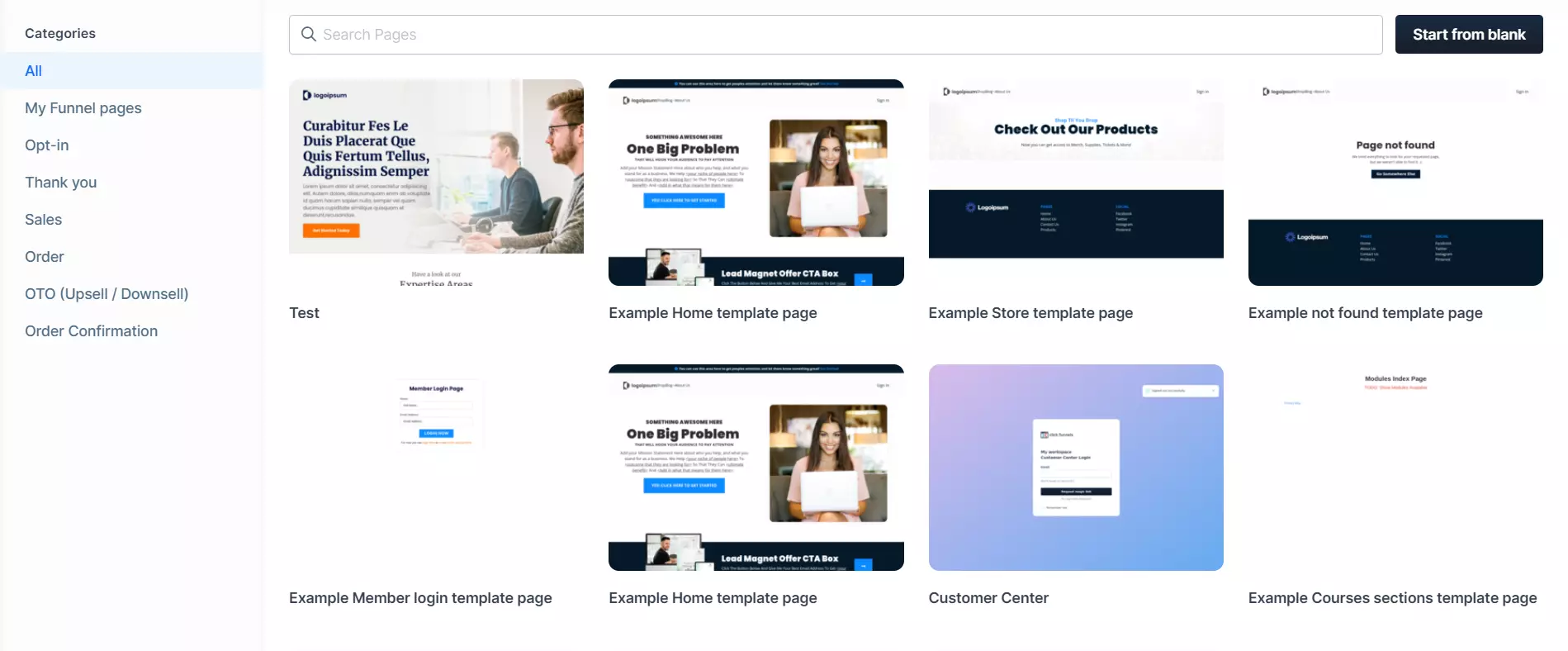
ClickFunnels offers 160+ page, form, and popup templates by default. You can choose between templates based on their purpose (e.g., opt-in, thank you, sales, order, etc.). Most templates fall under the Opt-in category, with 62 available. These include squeeze pages and popups.
You also access hundreds of additional free and premium templates via the ClickFunnels Marketplace.
Landingi
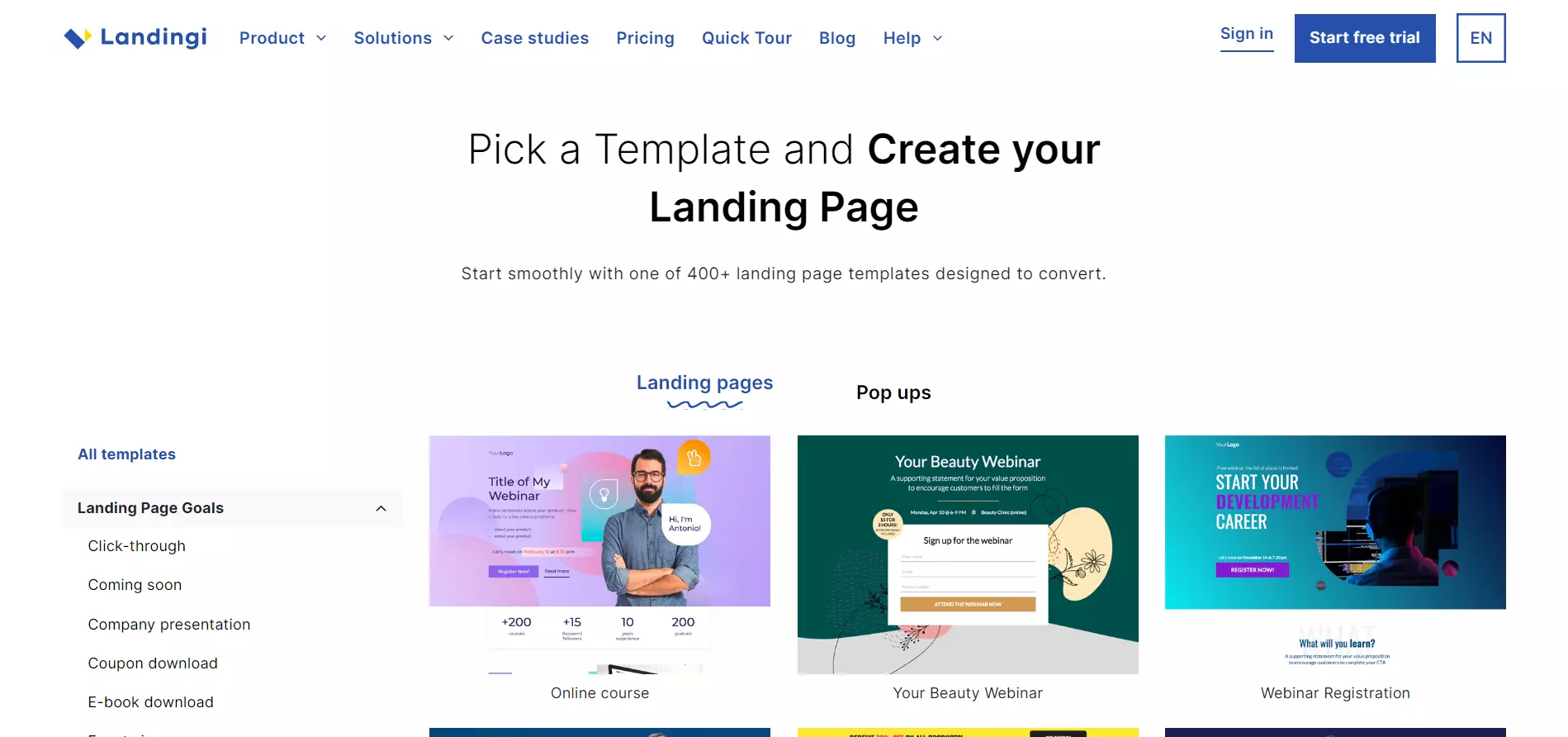
Landingi offers 400+ landing page and popup templates. The platform’s landing page templates are spread across the following categories:
- Landing page goals (e.g., coupon download, click-through, coming soon, etc.)
- Industry (e.g., finance, eCommerce, education, consulting/coaching, etc.)
Most templates are found under the sale of products/services category (73). As for filtering templates by industry, consulting/coaching offers the largest variety (41).
Moreover, you can filter popup templates by goals (e.g., subscribe, discount, cross-sell, and more). Most are found in the discount category (29).
Comparing Building Pages At Scale
Unbounce
Although the Smart Builder allows for quick landing page design and deployment, Unbounce covers a few more functionalities for building pages on a larger scale.
For one, there are section templates, which allow you to add pre-designed templates on specific areas of your landing page. For instance, there are footer, header, form, pricing templates, and more — ideal for maintaining consistency across multiple pages easily.
All you have to do is to drag and drop your selected section template to the landing page and customize it from there.
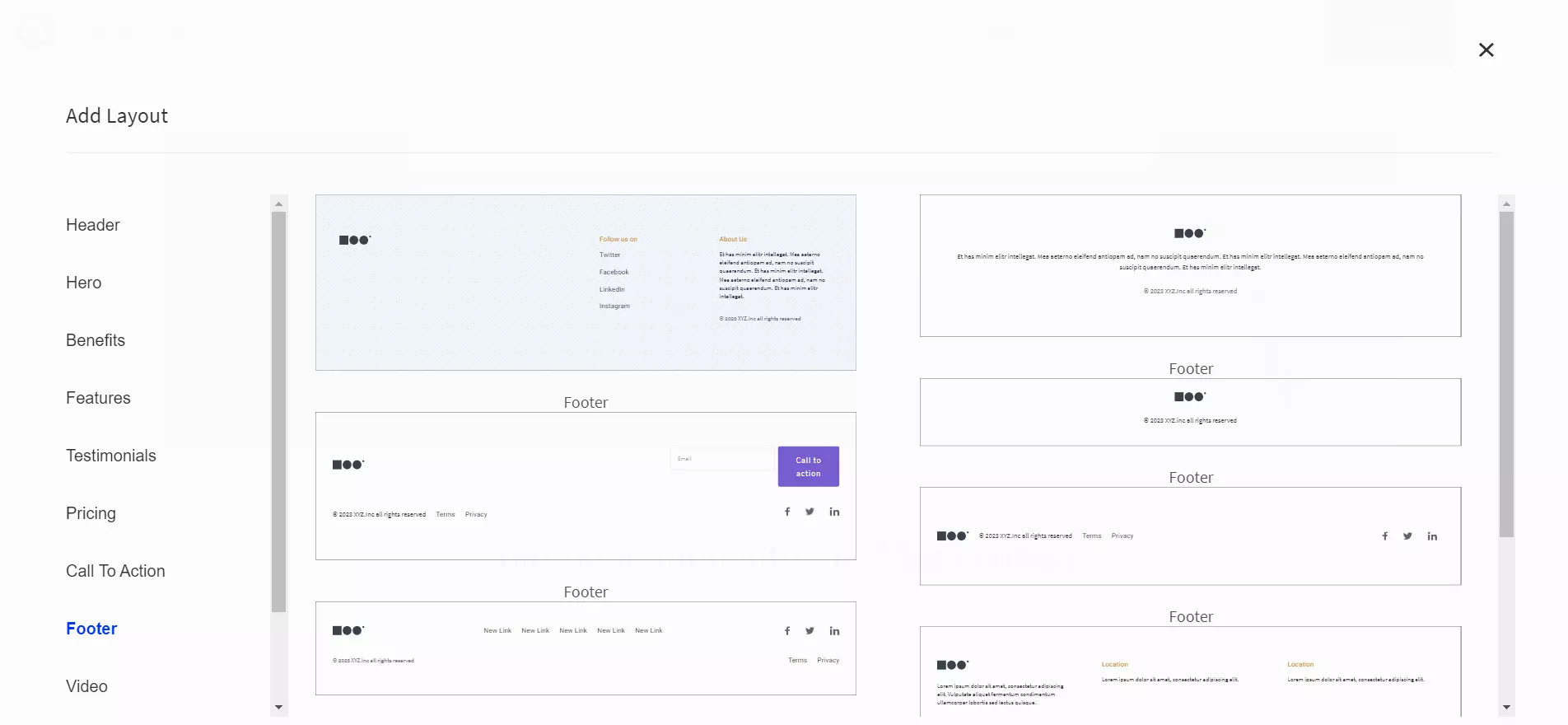
Moreover, you can duplicate sticky bars, pages, and popups to easily implement existing high-performing design elements in new landing pages.

Lastly, you can invite users and clients, as well as manage their permissions to organize projects more effectively.
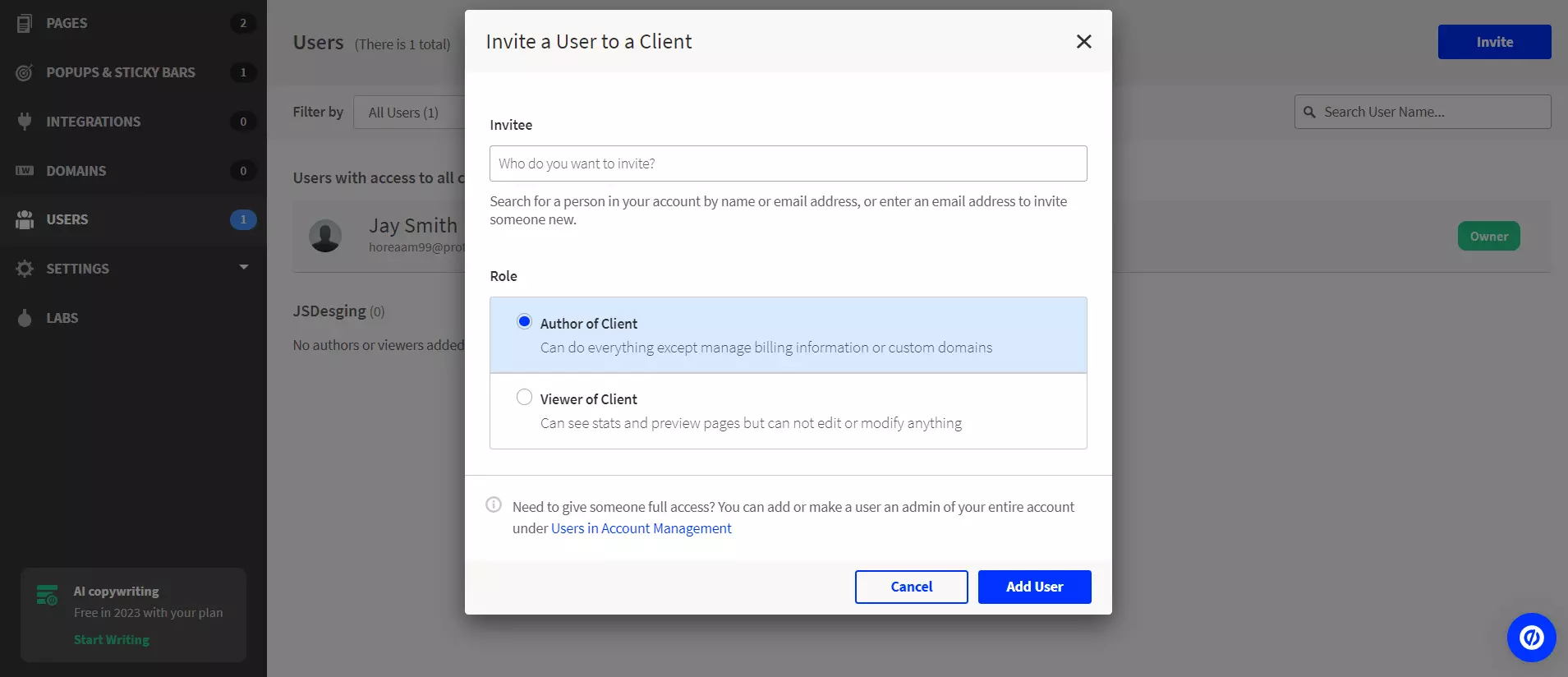
ClickFunnels
The Funnel Builder is ClickFunnels’ stand-out feature. As the name suggests, this functionality allows you to create sales funnels from beginning to end — perfect for monitoring and nurturing leads down the customer journey.
You can create pages dedicated to each step of the sales funnel and easily link them together. For instance, you can start with a landing page that promotes your product, link it to a product order page, move on to an upsell page, and then finish off with a thank you page.
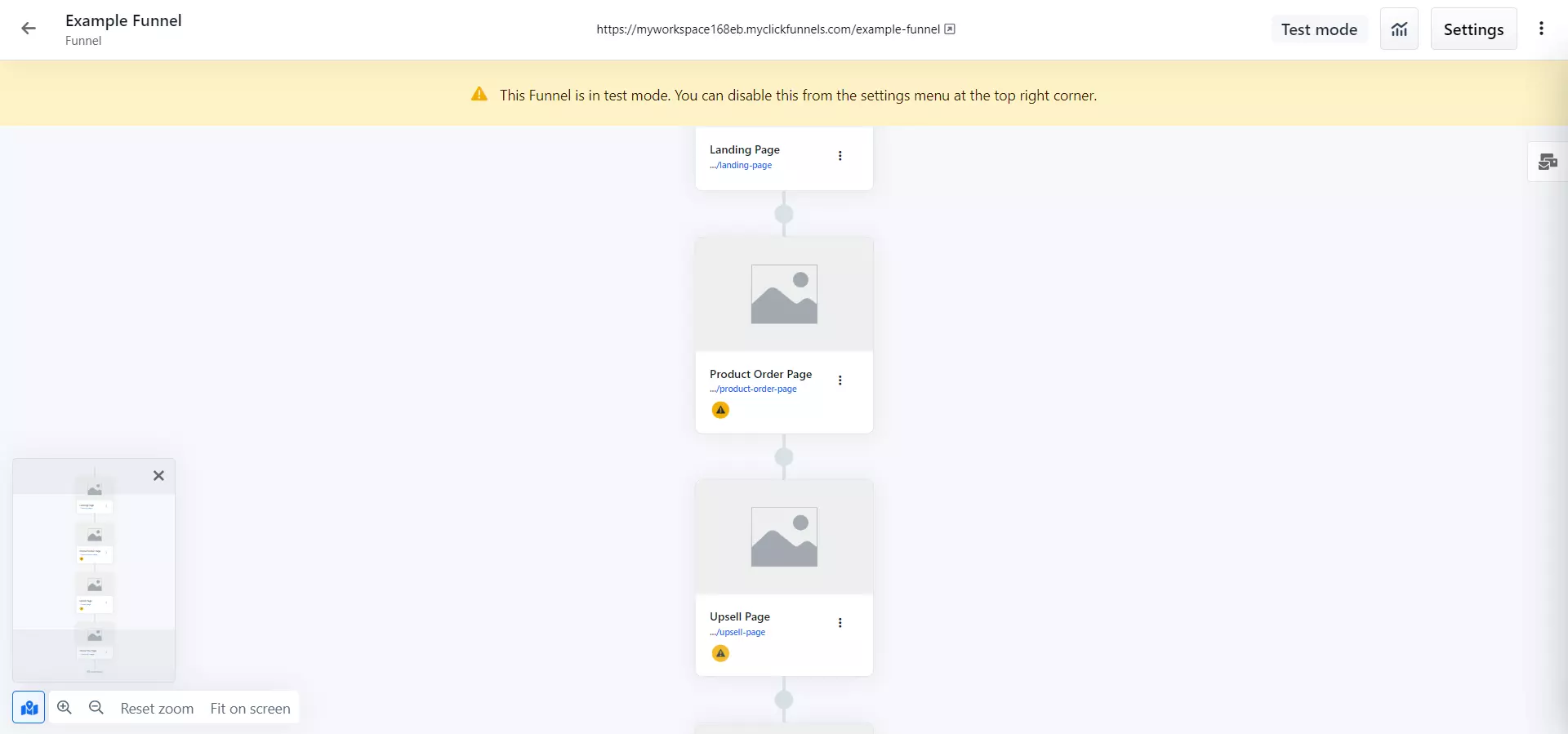
There are also various funnel templates available, so you can start the design process immediately.
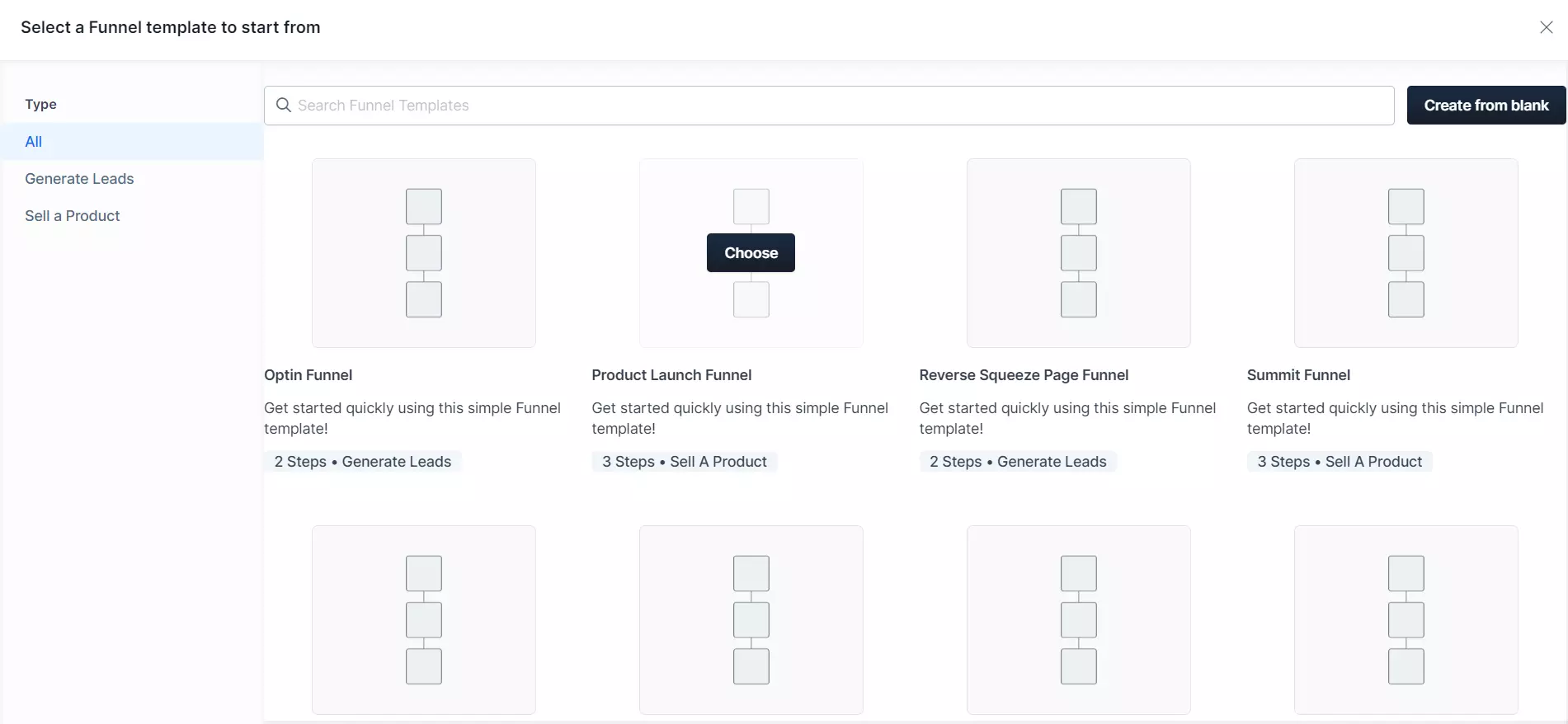
Moreover, ClickFunnels allows you to create complete websites. As such, you can build and link multiple web pages (e.g., home, coming soon, error, about us pages, and more).
There are also Universal Sections. You can save a specific page section (e.g., headers and footers) and add it to multiple web pages. Whenever you edit the said section, the changes will automatically apply to all the web pages containing it.
However, ClickFunnels lacks ready-made section templates.
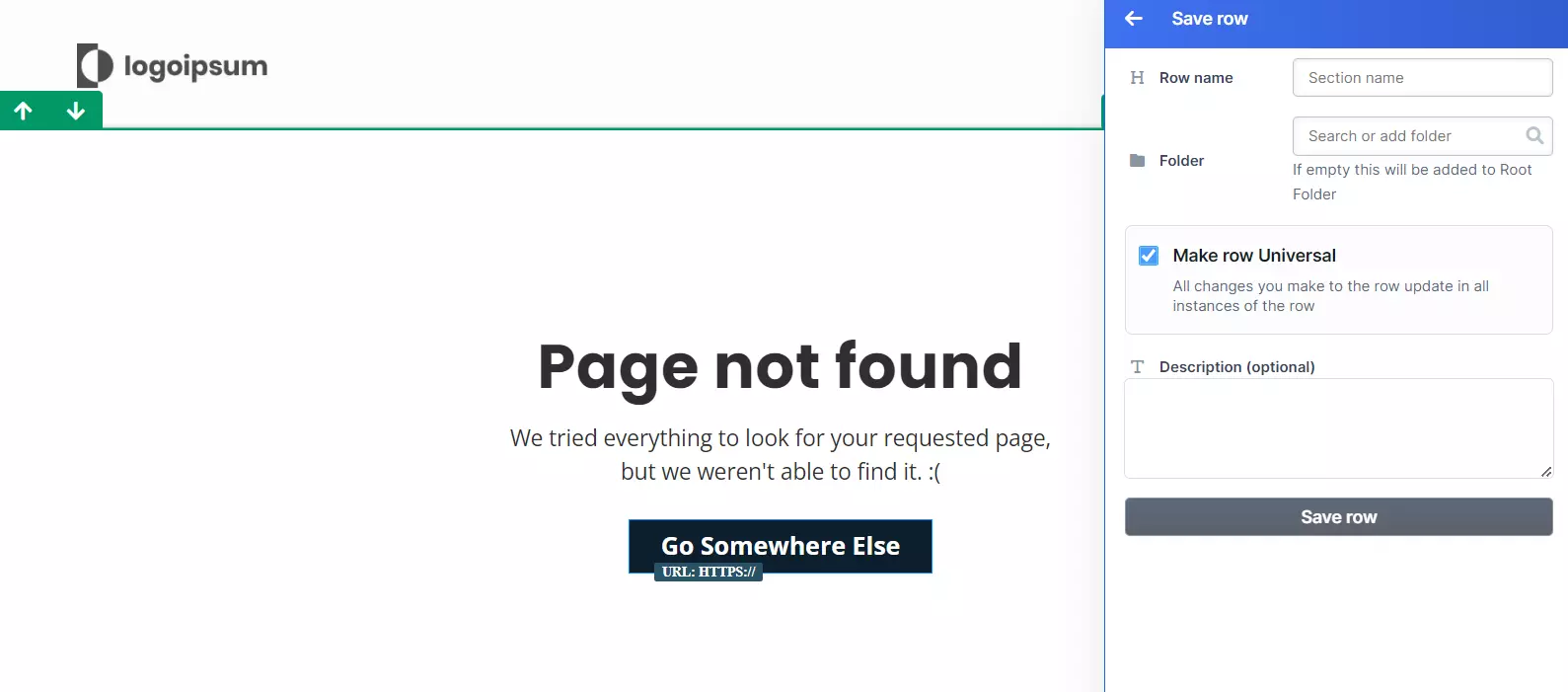
Lastly, you can set up style guides to create custom color schemes and easily maintain consistency between your pages.
Landingi
Landingi offers Smart Sections and section templates. The Smart Sections functionality is similar to ClickFunnels’ Universal Section (allowing you to create sections that can be easily updated at once across multiple pages).
Meanwhile, section templates offer a broad range of ready-made designs fit for various purposes/areas within your landing page. Landingi’s section templates are more versatile compared to Unbounce.
Unlike Unbounce, Landingi also offers section templates with countdown timers, opening hours, portfolios, thank-you messages, and much more.
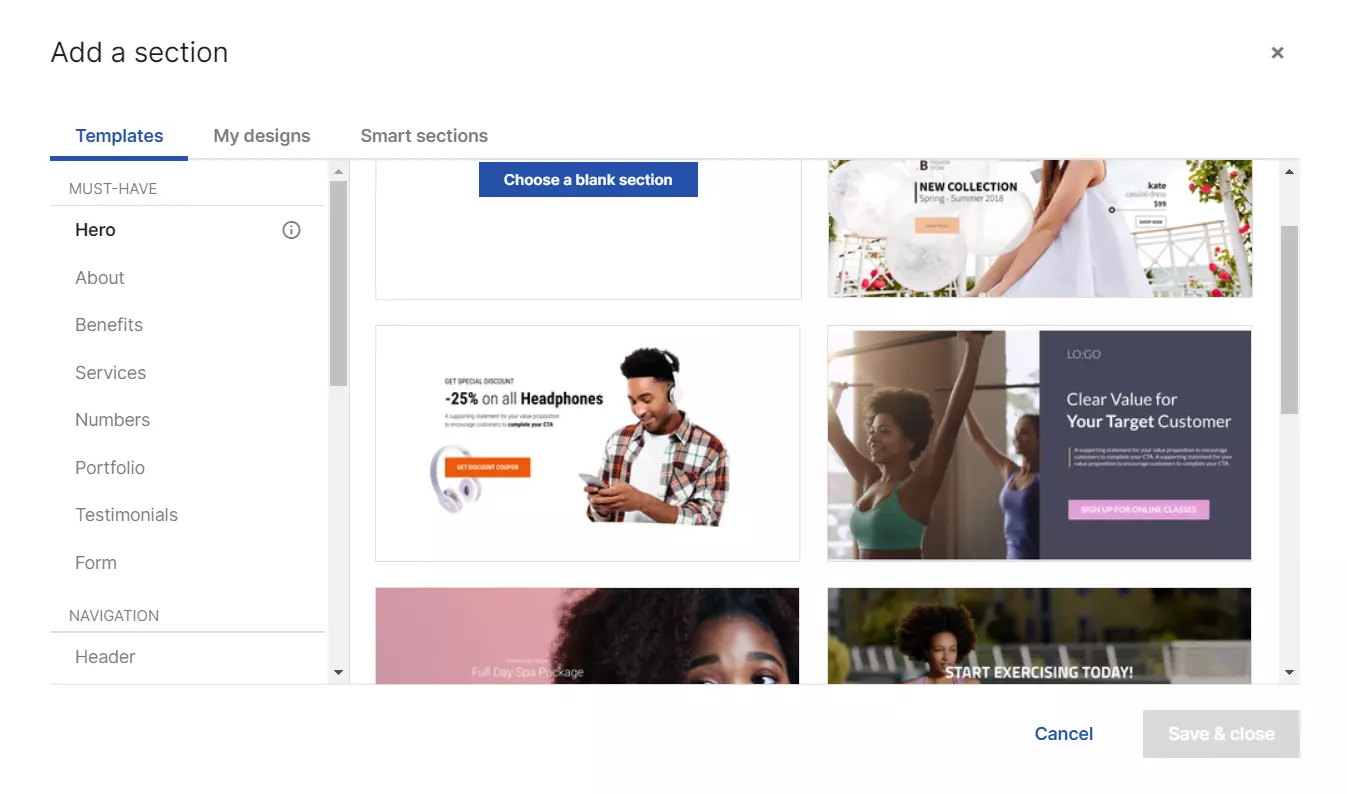
Additionally, you can connect multiple landing pages to create funnels.
Lastly, there’s Sub-Account Management (an extra add-on). This package allows you to invite clients to your account, let them create pages on their own, and set sub-account resource usage limits.
Comparing Available Integrations
Unbounce
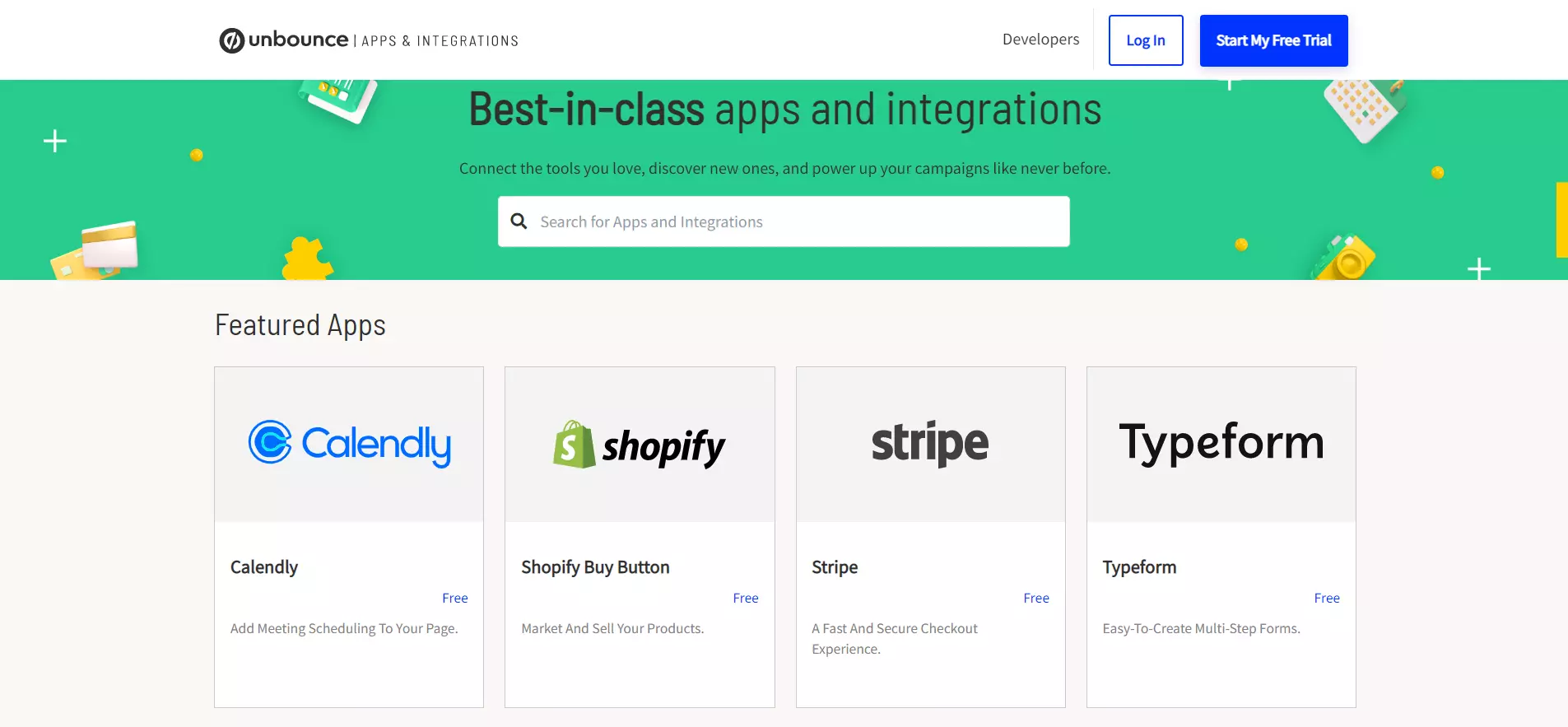
Unbounce includes 52 apps and integrations with the option to use Zapier to access 5,000+ additional applications.
Popular Unbounce integrations include Google Analytics, Salesforce, Calendly, PayPal, and more.
ClickFunnels
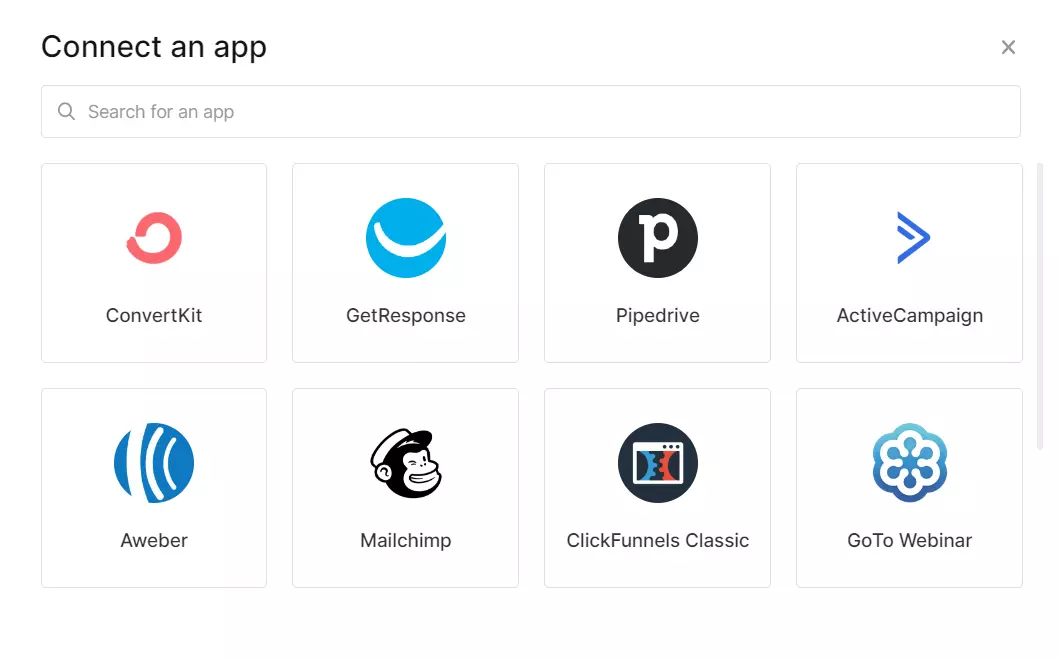
ClickFunnels only integrates with ten other platforms like Pipedrive, Mailchimp, ActiveCampaign, and more. However, you can connect ClickFunnels with Zapier to extend the platform’s functionality.
Landingi
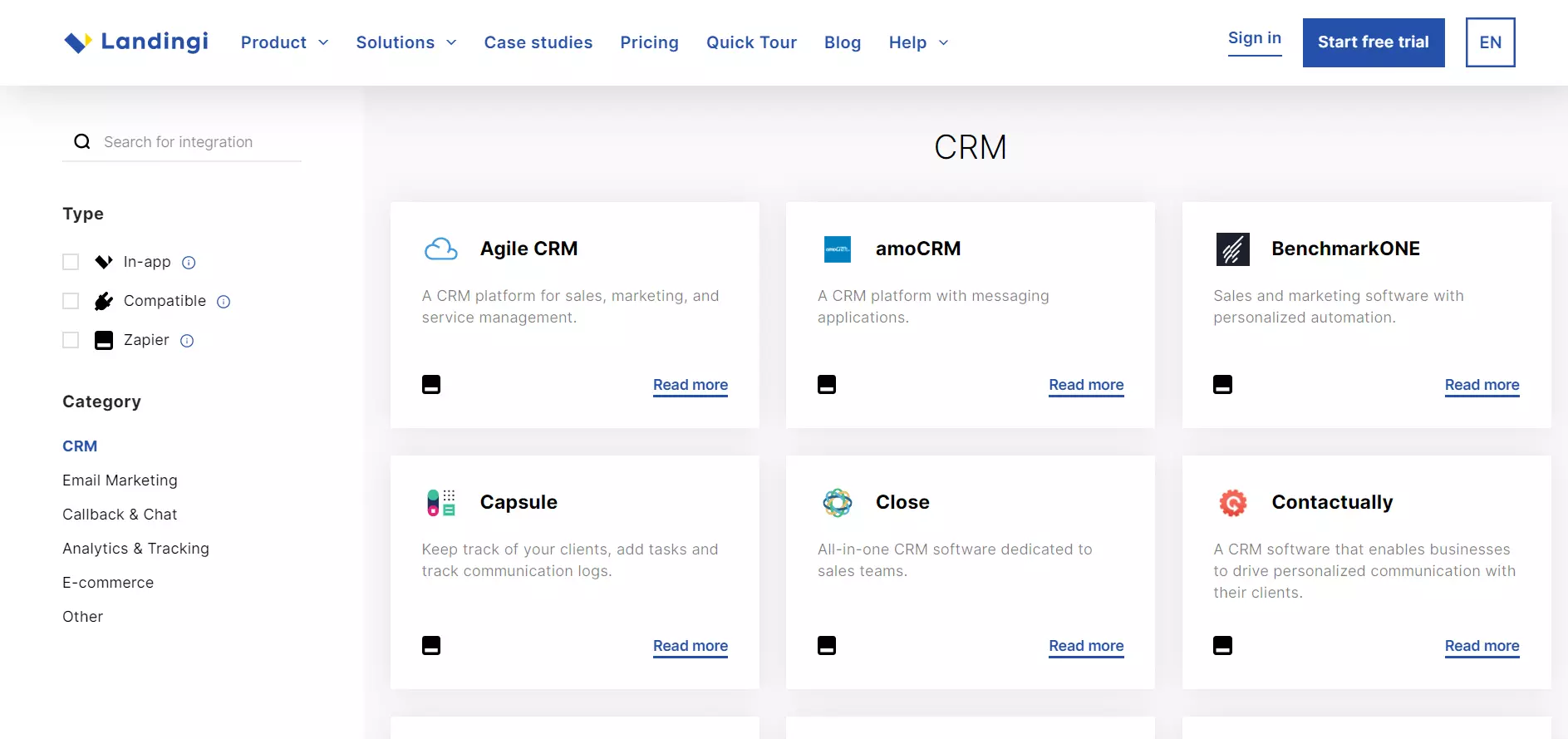
Landingi is the strongest of the bunch in this regard. The platform integrates with 150+ apps, including CRM, email marketing, eCommerce tools, and more.
Some examples include Zoom, HotJar, Agile CRM, BigCommerce, LiveWebinar, etc. There’s also the option to integrate Landingi with Zapier to access 5,000+ additional applications.
Comparing Pricing
Unbounce

Unbounce offers four pricing plans:
- Launch – $99/month (monthly), $74/month (annually): For two users, one domain, and 20,000 monthly unique visitors. Includes custom templates, traffic reports, popups/sticky bars, etc.
- Optimize – $145/month (monthly), $109/month (annually): For unlimited users, five domains, and 30,000 monthly unique visitors. Includes A/B testing, content scheduling, and PPC Dynamic Text Replacement.
- Accelerate – $240/month (monthly), $180/month (annually): For ten domains and 50,000 monthly unique visitors. Offers audience targeting tools and trigger options for popups/sticky bars.
- Concierge – $625/month (monthly), $469/month (annually): For 25+ domains and 100,000+ monthly unique visitors. Includes all of the above.
There’s a 14-day free trial for all plans, except Concierge.
ClickFunnels

ClickFunnels covers three pricing plans:
- Basic – $147/month (monthly), $127/month (annually): Available for up to one website, 20 funnels, one domain, and one admin user. Holds 10,000 contacts, three courses, and 1,000 students. Includes basic analytics.
- Pro – $197/month (monthly), $157/month (annually): Available for up to one website, 100 funnels, three domains, and five admin users. Holds 25,000 contacts, 15 courses, and 10,000 students. Includes API access, Liquid Theme Editor, ShareFunnels, etc.
- Funnel Hacker – $297/month (monthly), $208/month (annually): Available for up to three websites, nine domains, and 15 admin users. Offers unlimited funnels, and holds 200,000 contacts, 200 courses, and 10,000 students. Includes advanced analytics.
There’s a 14-day free trial available for all plans.
Landingi

Landingi offers three pricing plans:
- Free: Publish one landing page, access 30-day data retention, and sync data once/a day.
- Professional – $49/month (annually): Publish unlimited landing pages, access 365-day data retention, sync data in real-time, use all of Landingi’s features, and more.
- Agency – $149/month (annually): Access 3-year data retention, create unlimited client workspaces, set up advanced permissions, and perform audit logs.
There’s a 14-day free trial for the Professional plan.
Comparing Unique Features
Unbounce
Smart Traffic
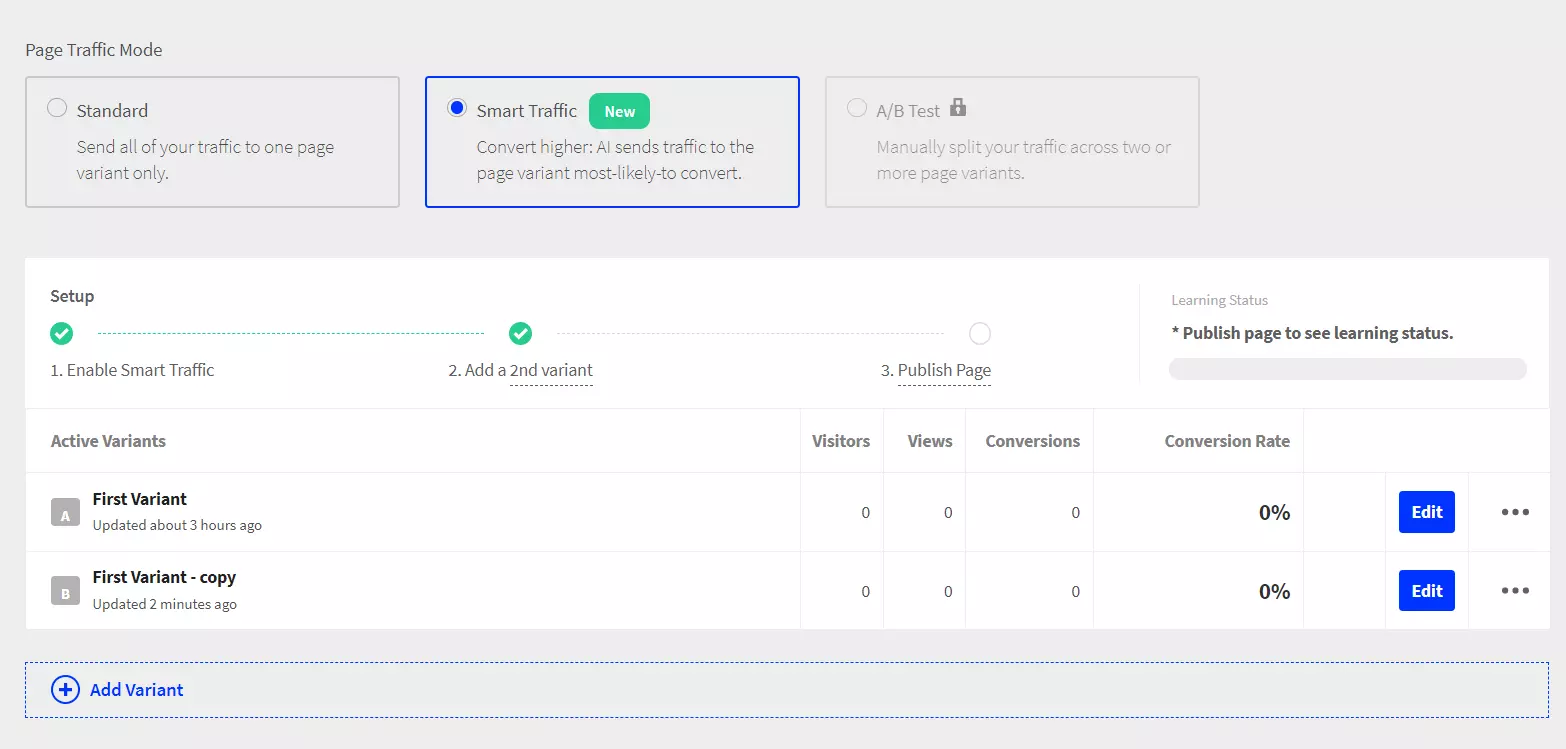
Smart Traffic leverages AI to test multiple variants of the same web page. Unlike traditional A/B testing tools, Unbounce allows you to examine multiple variables at once (e.g., CTAs, hero images, and headlines).
Smart Traffic measures your page variants’ performance and will automatically send visitors the winning variation based on specific attributes, like their device, browser, location, and more. Unbounce also offers standard A/B testing.
Smart Copy
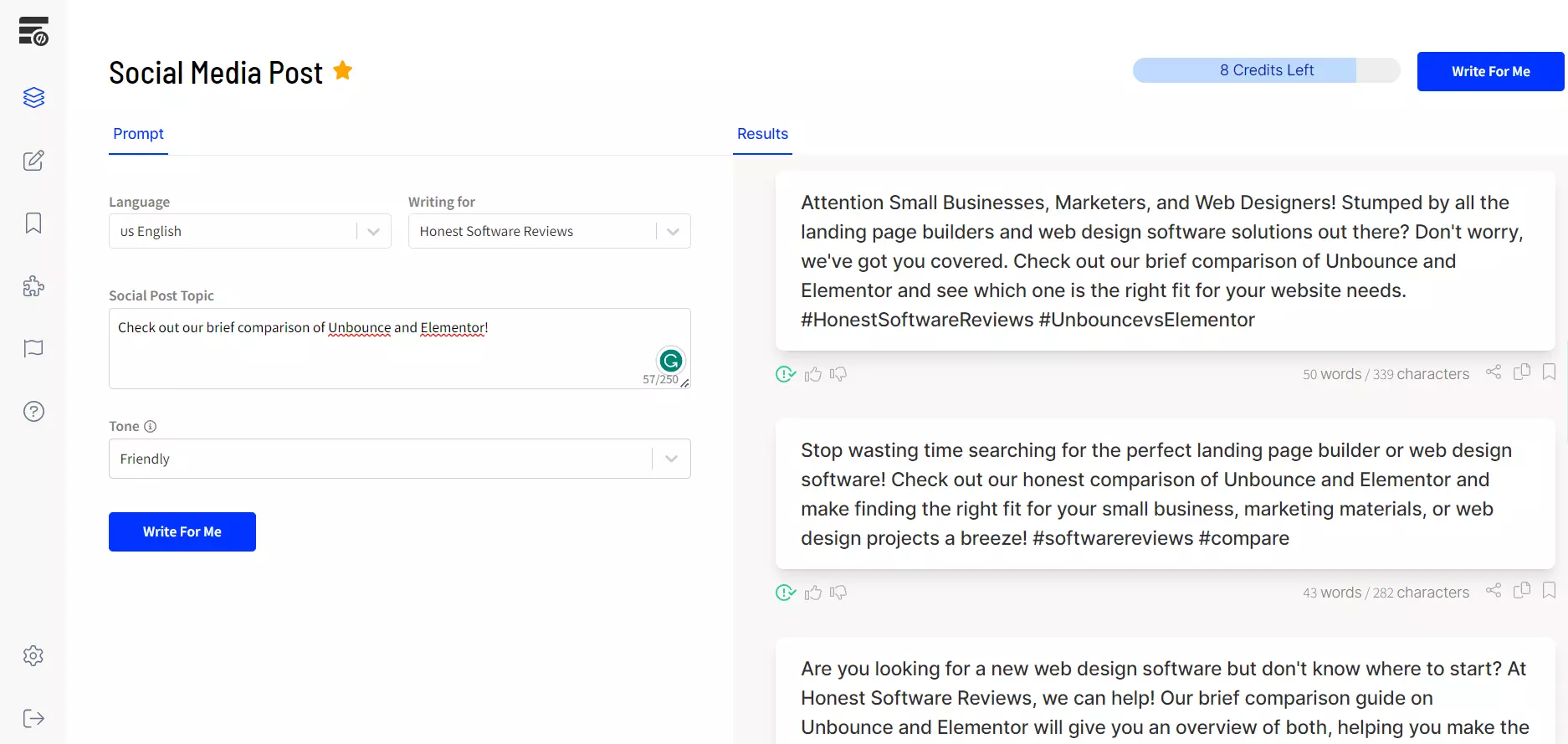
Smart Copy creates written content for social media posts, landing pages, ads, emails, meta descriptions, and more. This functionality works similarly to the Smart Builder — select your company’s industry, pick your content’s purpose, and Unbounce will generate copy based on your choices.
You can use Smart Copy for free, but there are also separate paid plans available.
ClickFunnels
Course builder
ClickFunnels includes a dedicated course builder. The platform offers various course templates. You can then divide your course into different modules, and split your modules into multiple lessons.
Additionally, ClickFunnels allows you to schedule your course directly within the platform. For instance, you can gradually give students access to more modules over time.
Moreover, the platform allows you to leave internal notes on each course, which is ideal for keeping track of your ideas and highlighting where you want to update or add more to your courses.
Built-in email marketing
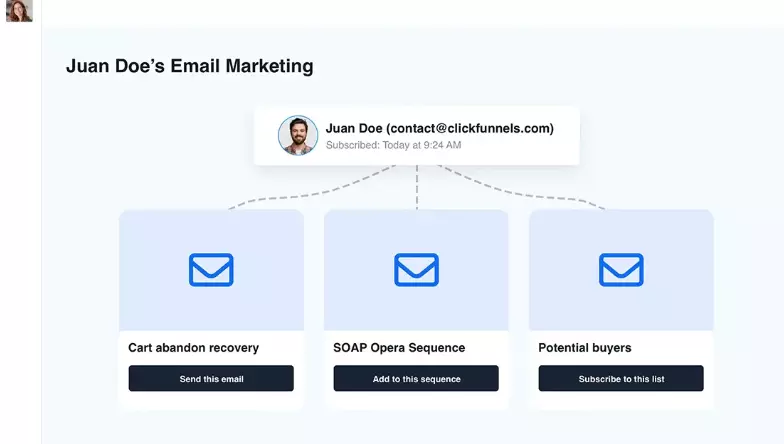
ClickFunnels also offers a built-in email marketing tool, allowing you to easily create, schedule, and send email campaigns. You can craft emails via the platform’s various templates or build them from scratch. This functionality also goes well with ClickFunnels’ CRM system.
Additionally, you can couple ClickFunnels email marketing tool with its automated workflows to easily send automatic targeted campaigns.
Landingi
Order tracking
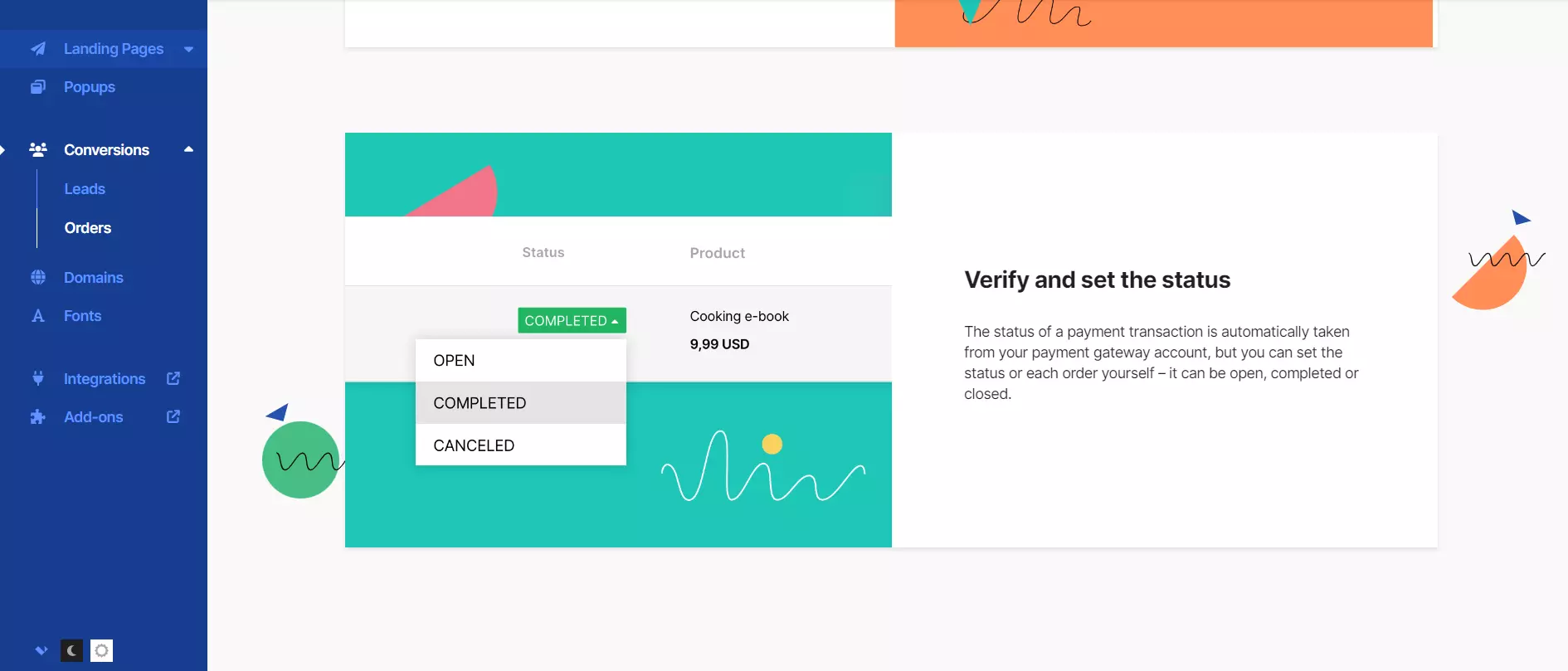
You can integrate Landingi with PayPal, PayU, or Stripe so visitors can purchase products from your landing page. Each purchase will appear under the Orders tab. From there, you can monitor payment status, transaction dates, and sold products.
Rebuild Mobile
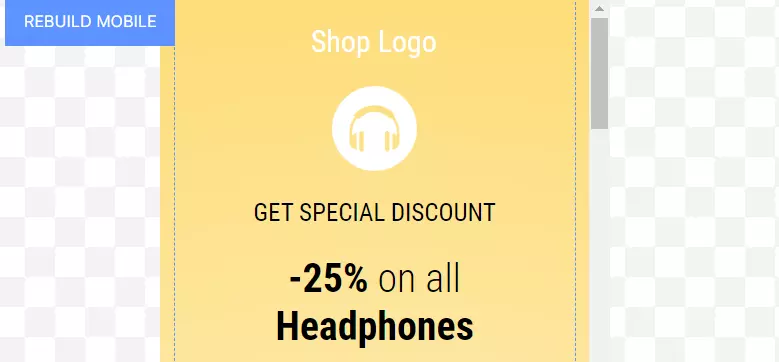
If you’re not happy with your page’s mobile layout, there’s no need to adjust it manually. Landingi’s Rebuild Mobile functionality automatically tweaks the placement of design elements and makes the most out of the limited space of mobile screens.
You can either rebuild a landing page in its entirety or alter specific sections. You can then fine-tune the placement of design elements by manually tweaking them to your liking.
Unbounce Vs. ClickFunnels Vs. Landingi: The Verdict
Overall, all three platforms discussed in this article are excellent choices. However, each fulfills its specific set of purposes.
Unbounce is a solid option for marketing agencies looking to quickly set up and deploy a large volume of landing pages for their clients.
On the other hand, ClickFunnels is excellent for medium and large companies that do not necessarily seek a highly flexible page builder but are more interested in an all-in-one solution that allows them to build on their lead nurturing process.
Besides the funnel builder, ClickFunnels also comes with solid CRM and email marketing tools.
Meanwhile, Landingi is suitable for both situations. It can offer its own set of powerful AI functionalities, but also includes lead management. Not to mention that you use it to create sales funnels too.
However, we believe that Landingi excels in its landing page design capabilities. Landingi includes the most free templates and integrations out of the three by far. Additionally, it offers smart sections and a pixel-perfect editor (unlike ClickFunnels) at a more affordable price.

